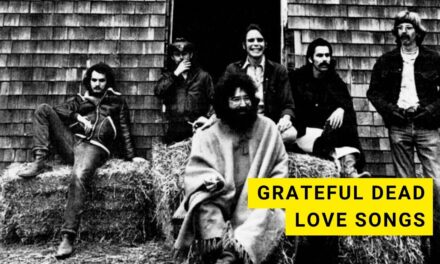In recent years, the guitar playing technique known as songs in open D has gained immense popularity among musicians. The technique involves tuning the guitar strings to a specific open D tuning to produce a rich, resonant sound. While the technique can be challenging to learn, it has proven to be a powerful tool for seasoned players and novice songwriters alike. With its distinctive tonality and versatility, open D tuning has become a go-to style for many guitarists, adding a unique twist to their performances and compositions.
“Love in Vain” – Robert Johnson
Robert Johnson’s haunting “Love in Vain” showcases his virtuosity in open D tuning, with its melancholic melody and evocative lyrics conveying feelings of heartache and loneliness. The song’s intricate fingerpicking patterns and the interplay between the vocal and guitar parts are a testament to Johnson’s musical genius, making it one of the quintessential blues classics of all time.
“When the Levee Breaks” – Led Zeppelin
One of the most prominent examples of a song in Open D tuning is a classic rock staple from Led Zeppelin. This tune employs a driving rhythm and slide guitar work that’s become synonymous with the Zep sound. Though it’s been covered by countless other artists, the original track stands as a testament to the band’s iconic flair for heavy rock n’ roll with riffs that are both simple and insanely catchy.
“Death Letter” – Son House
The tumultuous and somber melody of this tune echoes the emotions of the lyrics as they tell the haunting yet captivating story of a man writing a letter to his lover. The guitar work featured in this song is masterful and showcases the power of the open D tuning in creating a unique and rich sound. Its simple yet potent structure and impassioned delivery make it a standout in any collection of songs in Open D tuning.
“Little Martha” – The Allman Brothers Band
The Allman Brothers Band’s “Little Martha” is a kaleidoscopic instrumental piece that showcases the intricate fingerpicking of Duane Allman. The composition was dedicated to his then-infant daughter and features a delightful melody that ebbs and flows like waves. The song sets a serene and contemplative atmosphere with its celestial harmonies and gentle nuances, making it an exemplary display of what an open D tuning can accomplish. Allman’s guitar work is a testament to his virtuosity and a nod to the influence of Delta blues on the band’s Southern rock roots.
“Rollin’ and Tumblin'” – Muddy Waters
This particular track is a hallmark of the Delta blues style and features evocative slide guitar playing by the mighty Muddy Waters. The song’s hypnotic rhythm and raw, bluesy vocals paint a vivid picture of struggle and hardship, all while showcasing the unique tonality and expressive potential of open D tuning. A true classic of the genre and an essential example of how this tuning can be used to create some of the most powerful and emotive music there is.
“Statesboro Blues” – Blind Willie McTell
Blind Willie McTell’s “Statesboro Blues” is a quintessential example of a classic blues song in Open D tuning. The intricate interplay and syncopated rhythms between the guitar and vocal melody create a powerful, yet subtle, complexity that weaves together seamlessly. McTell’s slides and bent notes effortlessly infuse a sense of soulful expressiveness, while the steady bass line provides a solid foundation for the entire song. It’s no wonder that this song has been covered by countless artists over the years, as its timeless beauty continues to captivate and inspire musicians to this day.
“The Cuckoo” – Doc Watson
This traditional American folk song showcases the beautiful simplicity of open D tuning on the guitar, with intricate fingerpicking patterns and a soulful, haunting melody. The acoustic guitar serves as the perfect accompaniment to the sparse, melancholic vocals, capturing the essence of the blues and conveying a sense of raw emotion and authenticity. The song’s lyrics explore themes of lost love and heartbreak, invoking a sense of nostalgia and longing. Musicians of all levels can appreciate the beauty and expressiveness of this timeless classic.
“The Sky Is Crying” – Elmore James
“The Sky Is Crying” is a blues song with a captivating melody that showcases Elmore James’ dynamic slide guitar abilities. As a tune in open D, it employs a tuning that provides a wealth of harmonic possibilities and a rich, resonant tone. James’ signature vibrato and skillful phrasing are on full display, imparting an aura of wistful longing and heartbreak to the track. With its evocative delivery and expert musicianship, “The Sky Is Crying” leaves a profound and indelible impression on the listener.
“Walkin’ Blues” – Robert Johnson
“Walkin’ Blues” is a track written by Robert Johnson, a legendary bluesman who’s known for his innovative musicianship. The song features an open D tuning, which is characterized by a rich, resonant sound that’s well-suited for slide guitar playing. Johnson’s soulful vocals and intricate guitar work have endeared this song to generations of blues fans around the world. “Walkin’ Blues” is an excellent example of Johnson’s mastery of the blues form and his innovative use of open tunings, which have had a lasting impact on modern guitar playing.
“Baby Please Don’t Go” – Big Joe Williams
The tune in question is one that many claim is the originator of the boogie-woogie sound – a deep, driving rhythm with a powerhouse vocal delivery. It features the kind of repetitive, hypnotic guitar riff that gives it a nearly trance-like quality, making it perfect for listeners looking to get lost in the music. Despite being nearly a century old, this piece still manages to feel fresh and modern, a testament to the timeless power of the open D tuning.
“Big Road Blues” – Tommy Johnson
Johnson’s “Big Road Blues” is a captivating embodiment of the quintessential blues form. Set in Open D Tuning, a popular tuning for blues guitarists, the song invites a sense of curiosity with its erratic and elusive guitar rhythms, and ruminative lyrics exploring the depths of the blues experience. The song’s alluring melody and infectious groove, endowed with raspy, intimate delivery, offer ingrained, emotional resonance and undeniable power which defines the blues genre.
“Boogie Chillen” – John Lee Hooker
The upbeat tune with catchy riffs and driving rhythm in Open D tuning features a unique sound with a bottleneck slide and sparse use of vocals. The minimalist approach to the blues composition accentuates the instrumentals with a distinctive style applied to the traditional genre. Despite the relative simplicity, the song’s electricity leaves a lasting impression on listeners, making it a standout piece in the collection of songs that employ the Open D tuning technique.
“Bottle Neck Blues” – Sylvester Weaver
Sylvester Weaver’s “Bottle Neck Blues” is a remarkable example of a song in open D tuning. With its intricate bottleneck style, it showcases the rhythm and tone that open D creates. The song’s intricate fingerpicking skills and use of slide techniques give it a haunting feel. The lyrics of “Bottle Neck Blues” feel as if they were born in the depths of the Mississippi Delta. This song epitomizes the blues as a genre and makes open D tuning one of the most sought-after tunings in music history.
“Canned Heat Blues” – Tommy Johnson
This track by a legendary blues artist is a haunting and powerful example of the fingerstyle bottleneck technique in Open D tuning. With a mesmerizingly raw sound that showcases the full range of expressive possibilities afforded by this tuning, the song is a deeply emotional journey that never fails to leave listeners moved and inspired. From its driving, syncopated rhythms to the soulful, yearning slide guitar work, this track is a true masterpiece and a testament to the enduring power of the blues.
“Come On In My Kitchen” – Robert Johnson
“Come On In My Kitchen” is a haunting acoustic blues song by Robert Johnson that features his intricate fingerpicking in Open D tuning. The song showcases Johnson’s vocal range, with its sliding phrases and emotive intervals that create a sense of desperation. Johnson’s gravelly, evocative voice paired with his guitar work make the track an influential benchmark for future blues musicians, despite its enigmatic lyrics. Listening to this song evokes a sense of desolation and longing, leaving the listener with an indelible sense of melancholy.
“Cross Road Blues” – Robert Johnson
This particular track showcases the technical and emotional prowess of a legendary blues musician. Its intricate fingerpicking patterns and soulful lyrics exemplify the power of open D tuning in evoking a deep sense of yearning and loss. The haunting melody and rhythmic complexity of the instrumentation make it a standout song in the genre, and a testament to its enduring impact on modern music.
“Diddie Wa Diddie” – Blind Blake
This tune sits among the pantheon of iconic tunes played in the Open D tuning. With its syncopated fingerpicking style and jazzy melodic twists and turns, it is a masterpiece in the blues genre. The song’s chord progression, defined by its intricate use of harmonics, has been emulated by countless guitarists and influenced modern reimagining. Its lyrics are steeped in a range of themes, from betrayal to heartbreak, casting a broader appeal that ties into the enduring allure of the blues.
“Diving Duck Blues” – Sleepy John Estes
The illustrious Sleepy John Estes’ “Diving Duck Blues” exists as a delightful showcase for blues in open tuning. The technical wizardry of Estes as he deftly moves between a slide guitar’s frets is a sight to see, and his soulful voice offers a true testament to his passion for the roots of American music. The song holds a timeless charm and serves as a must-listen for aficionados seeking to immerse themselves in the craft.
“Dry Spell Blues” – Son House
This track’s moody, hypnotic vibe is emblematic of the “open D” tuning style, with intense, soulful vocals entertaining mellow acoustic riffs. It strikes an eerie and deeply introspective chord, with lyrics that seem to grapple with life’s darker moments.
“Fixin’ to Die Blues” – Bukka White
This track is emblematic of the emotionally-strained and melancholic mood that characterizes much of the blues genre. With its raw, unvarnished sound, this song’s themes of hardship, desperation, and uncertainty are conveyed through its powerful imagery and poetic lyrics. Listeners will be captivated by the haunting, almost otherworldly quality of this deeply stirring and evocative composition.
“Future Blues” – Willie Brown
The 24th song on our list is a haunting tale of sorrow and desperation, featuring intricate fingerpicking patterns and gut-wrenching lyrics that tug at the heartstrings. With its open D tuning and bluesy inflections, this track showcases the raw power and emotional intensity of traditional Delta blues. Whether you’re a seasoned blues musician or a curious listener, this song is sure to leave a deep and lasting impression. So grab your slide and get ready to explore the dark and mysterious world of open D tuning.
“Grinning in Your Face” – Son House
This composition showcases the unique tonality of open D tuning, with its hauntingly intricate fingerpicking patterns and mournful phrasing. The raw and expressive vocal delivery of the artist adds a sense of emotional depth to the song, painting a vivid picture of the pain and suffering experienced by those living through difficult times. Despite the melancholic nature of the piece, there is a sense of resilience and perseverance that shines through in each note, making it a powerful and uplifting listening experience.
“Hard Time Killin’ Floor Blues” – Skip James
This elusive yet lively blues tune from Skip James is a triumph of the open D tuning. Melding his unique fingerpicking style with his haunting falsetto, James plays with a complexity that belies the seeming simplicity of the tuning. “Hard Time Killin’ Floor Blues” is a maelstrom of perplexing rhythms, surprising harmonies, and an unbridled energy that is sure to leave every listener mystified.
“I Can’t Be Satisfied” – Muddy Waters
“I Can’t Be Satisfied” by Muddy Waters is a quintessential Delta blues that showcases the power and versatility of open D tuning. The song’s resonant acoustic guitar serves as a rhythmic anchor for Waters’ emotive vocal delivery, which is supported by understated harmonica and percussion. The use of open D tuning provides ample opportunity for dynamic chord progressions and melodic embellishments, holding the listener’s interest through each verse and imbuing the track with a sense of urgency and restless energy.
“I’m So Glad” – Skip James
This blues gem is a captivating number characterized by its deep soulfulness and intricate guitar work. Its timeless melody and melancholic yet uplifting lyrics beg the listener to reflect on the hardships of love and heartbreak. The raw emotion and skillful musicianship on display make it a true standout in the world of open D songs and a must-listen for any true aficionado of the genre.
“It Hurts Me Too” – Elmore James
This haunting, bluesy tune showcases the unique, resonant sound of the open D tuning. Infused with Elmore James’ signature slide guitar style, “It Hurts Me Too” exudes a sense of raw emotion and vulnerability. The lyrics are mournful, telling of heartbreak and longing, with each word dripping with melancholy. James’ soulful vocals combined with the mournful slide guitar make for a compelling track that is sure to resonate with fans of the blues genre.
“Kind Hearted Woman Blues” – Robert Johnson
The enigmatic aura of “Kind Hearted Woman Blues” by Robert Johnson has puzzled music enthusiasts for decades. The song’s intricate fingerpicking pattern and haunting melody, combined with Johnson’s soulful vocal delivery, make it a standout in the realm of blues classics. In Open D tuning, this song showcases Johnson’s exceptional guitar skills and his ability to evoke emotion through his music. Its inclusion in the list of songs in Open D is a tribute to Johnson’s enduring influence on the world of blues music.






